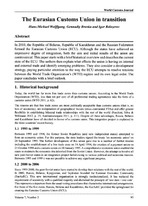| dc.contributor.author | Wolffgang, Hans-Michael | en |
| dc.contributor.author | Brovka, G. M. | en |
| dc.contributor.author | Belozerov, I. | en |
| dc.coverage.spatial | Munster | ru |
| dc.date.accessioned | 2019-04-10T11:31:06Z | |
| dc.date.available | 2019-04-10T11:31:06Z | |
| dc.date.issued | 2013 | |
| dc.identifier.citation | Wolffgang, Hans-Michael. The Eurasian Customs Union in transition / Hans-Michael Wolffgang, G. M. Brovka, I. Belozerov // World Customs Journal / ed.-in-chief David Widdowson. – 2013. – Vol. 7, № 2. – P. 93-103. | ru |
| dc.identifier.uri | https://rep.bntu.by/handle/data/51670 | |
| dc.language.iso | en | ru |
| dc.publisher | Australia and University of Munster | ru |
| dc.title | The Eurasian Customs Union in transition | ru |
| dc.type | Article | ru |
| local.description.annotation | In 2010, the Republic of Belarus, Republic of Kazakhstan and the Russian Federation formed the Eurasian Customs Union (ECU). Although the states have achieved an impressive degree of integration, both the aim and initial results of the union are controversial. This paper starts with a brief historical overview and describes the current state of the ECU. The authors then explain what effects the union is having on internal and external trade and identify emerging problems. They also consider a development strategy, paying particular attention to the way the ECU attempts to resolve tensions between the World Trade Organization’s (WTO) regime and its own legal order. The paper concludes with a brief outlook. | en |

